If you’ve ever shaved or otherwise altered the length or look of your cat’s fur, you might be wondering how long it will take for it to grow back.
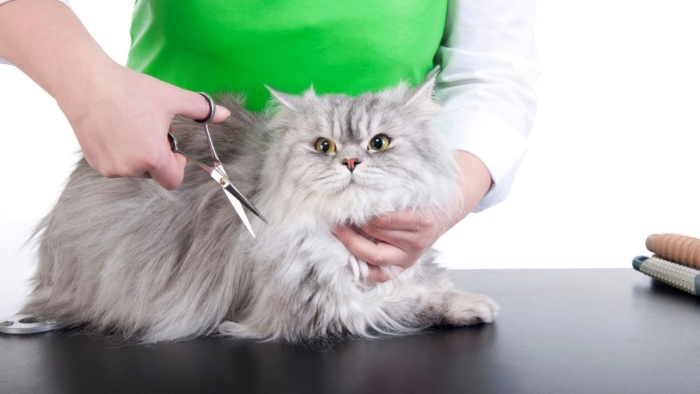
You want your cat to look and feel its best, whether it’s for an aesthetic purpose, like a lion cut, or for a medical cause, like surgery or matted fur.
In this article, we’ll address some frequently asked queries concerning cat hair development and offer some advice on how to both hasten the process and avoid hair loss.
The Cause of Hair Loss
The first thing to consider is why your cat lost its hair in the first place.
Some common causes of hair loss in cats are:
Shaving or trimming
Typically, this is carried out for medical purposes, including surgery, wound care, or diagnostic procedures.
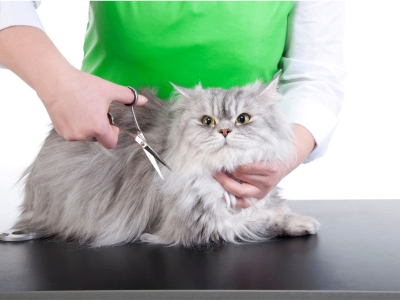
Additionally, it can be done for hygienic or aesthetic reasons, such as eliminating mats or knots.
Hair can regrow naturally after shaving or trimming since doing so just eliminates the hair shaft and does not harm the hair follicle.
Parasites
The skin and hair follicles can become inflamed, itchy, and damaged as a result of fleas, mites, lice, and other parasites.
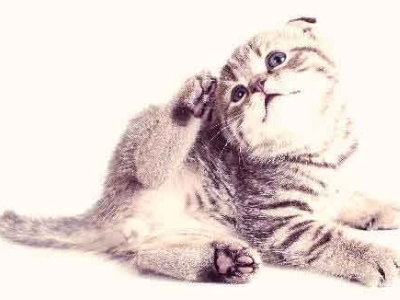
Either through scratching or the parasites themselves, this might result in hair loss[1].
In addition to spreading illnesses, parasites can also trigger allergic reactions that can stunt hair development.
For hair loss to cease and hair to regrow, parasites must be treated with the proper drugs and preventives.
Allergies
Food, pollen, dust, or flea bites are just a few of the things that cats might be allergic to.
Cats who have allergies may experience hair loss, itching, redness, and swelling.
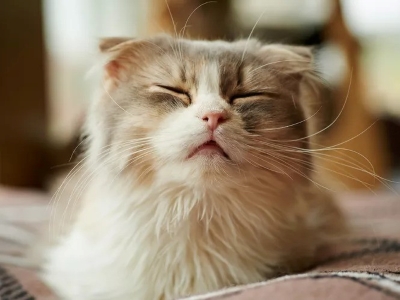
Your veterinarian can identify allergies and provide medication, dietary adjustments, or nutritional supplements as necessary.
For hair loss to stop further and for hair growth to occur, the allergen must be removed[2].
Infections
Bacterial, fungal, or viral infections can affect the skin and hair follicles of cats.
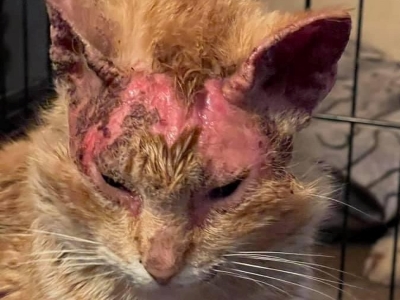
Some common infections that cause hair loss are ringworm, dermatophytosis, folliculitis, and feline herpesvirus.
Infections can cause symptoms such as crusts, scabs, pus, ulcers, or bald patches on the skin.
Infections need to be treated with antibiotics, antifungals, or antivirals, depending on the type and severity of the infection.
Treating the infection will help the skin heal and the hair grow back[3].
Hormonal imbalances
Hormones play a role in regulating the hair growth cycle of cats. Some hormones stimulate hair growth, while others inhibit it.
Hormonal imbalances can occur due to diseases such as hyperthyroidism, diabetes mellitus, Cushing’s syndrome, or adrenal tumors.
Hormonal imbalances can cause symptoms such as thinning of the coat, symmetrical hair loss on the sides of the body, or changes in the color or texture of the hair.
Hormonal imbalances need to be diagnosed by your vet and treated with medications or surgery, depending on the cause and severity of the condition.
Balancing the hormones will help restore the normal hair growth cycle and prevent further hair loss.
Stress
Stress can affect both the physical and mental health of cats. Stress can be caused by various factors, such as changes in the environment, routines, or social interactions.
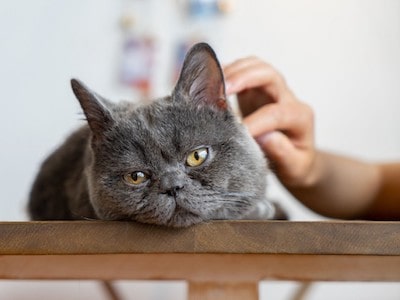
Stress can trigger a condition called psychogenic alopecia, which occurs when cats overgroom themselves due to anxiety or boredom.
This can lead to hair loss in areas that are easy to reach with their tongue, such as the belly, legs, or flanks.
Stress can also affect the immune system and make cats more susceptible to infections or allergies that can cause hair loss.
Stress can be managed by providing a calm and comfortable environment for your cat, enriching their daily activities with toys and playtime, and addressing any underlying issues that may be causing stress[4].
Reducing stress will help your cat relax and stop overgrooming.
The Type of Hair
Another factor that affects how long it takes for cat hair to grow back is the type of hair.
Cats have different types of hair on their bodies.
Guard Hairs
The intermediate layer of the coat is composed of these shorter, finer hairs. Insulation and warmth are provided by them.
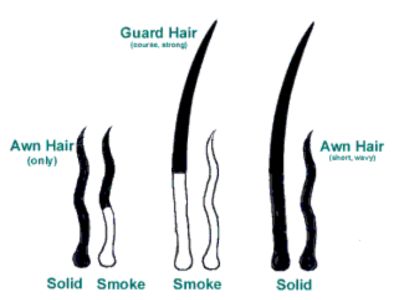
Awn Hairs
The intermediate layer of the coat is made up of these weaker, shorter hairs. They offer warmth and insulation.
Down Hairs
The inner layer of the coat is made up of these thinnest, shortest hairs. They offer comfort and suppleness.
Each type of hair has a different growth rate and duration.
Guard hairs grow slower but last longer than awn hairs or down hairs.
This means that if your cat loses guard hairs due to shaving or trimming, it will take longer for them to grow back than if they lose awn hairs or down hairs.
The Stage of Hair Growth Cycle
The third element that influences how long it takes for cat hair to regrow is the stage of the hair cycle.
The hair growth cycle consists of three phases:
- Anagen
When the hair is actively growing from the hair follicle, this is the growth phase.
Depending on the type of hair and the cat’s health, this stage might last anywhere from a few weeks to many months.
- Catagen
The hair stops growing and separates from the blood supply during this transitional stage.
From a few days to a few weeks, this period might endure.
- Telogen
Until a new hair pushes it out, the hair is in its resting phase in the hair follicle.
Depending on the cat’s health and the type of fur, this period may last from a few weeks to many months.
For every hair and every cat, the duration and timing of each phase might differ.
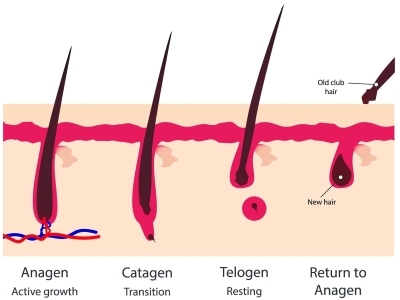
Some factors that can influence the hair growth cycle are:
- Season
Cats tend to shed more in the spring and fall, when they change their coat according to the temperature and daylight changes.
This means that more hairs are in the telogen phase and ready to fall out during these seasons.
- Breed
Some breeds of cats have longer or shorter hair growth cycles than others. For example, Persian cats have longer anagen phases and longer guard hairs than Siamese cats.
- Age
Cats’ hair cycles slow down as they age, and their coats are thinner and duller. This implies that it takes them longer to regrow their hair after losing it.
- Nutrition
A balanced and nutritious diet is essential for healthy hair growth.
Cats need adequate amounts of protein, fatty acids, vitamins, and minerals to support their skin and coat.
A deficiency or excess of any of these nutrients can affect the hair growth cycle and cause hair loss or poor-quality hair.
How to Prevent Hair Loss in Cats
The best way to prevent hair loss in cats is to keep them healthy and happy[5].
Here are some preventive measures you can take:
- Make sure your cat is eating a high-quality feed that meets their nutritional requirements.
- Select a meal that is suitable for your child’s age, size, activity level, and health status.
- Whenever possible, stay away from foods that include artificial colors, flavors, preservatives, or fillers since they might lead to allergic reactions or digestive issues.
- Select a meal that is suitable for your child’s age, size, activity level, and health status.

- Keep your cat well–groomed and moisturized. Always have fresh water available for them, and replace it every day.
- Regularly clip their nails and brush their hair. Inspect their skin, lips, ears, and eyes for indications of damage or illness.
- Bring them in for routine checkups and immunizations at the veterinarian.
- Regularly clip their nails and brush their hair. Inspect their skin, lips, ears, and eyes for indications of damage or illness.
- Keep pests and parasites away from your cat. Your cat may have hair loss and other health problems as a result of fleas, ticks, mites, and worms.
- Use a treatment that both prevents and cures these infestations.
- Prior to using any product, read the directions thoroughly and consult your veterinarian.
- Use a treatment that both prevents and cures these infestations.
- Reduce the tension and boredom in your cat. Your cat may overgroom or pluck out its hair as a result of stress and boredom.
This may result in behavioral issues, skin damage, and hairless patches.
- Create a stimulating and exciting environment for your cat so that they may exhibit their innate tendencies.
- Give them toys, scratching posts, hiding areas, and opportunities for interactive play.
- Avoid abrupt changes in their environment or habits that might frighten them.
- Consult a specialist if your cat exhibits symptoms of anxiety or depression, such as hiding, aggressiveness, or a lack of food.
- Create a stimulating and exciting environment for your cat so that they may exhibit their innate tendencies.
How Fast Does Cat Hair Grow?
The breed of the cat, the kind and length of their fur, the season, their nutrition, and their state of health all affect how quickly cat hair grows back.
However, as a general rule, you should expect long-haired cats to fully regrow their fur in 3 to 6 months and short-haired cats in 2 to 3 months.
Cat breeds vary in how quickly their fur grows. Persian cats, for instance, have extremely thick and long coats that might take up to a year to fully regrow.
Siamese cats, on the other hand, have short, sleek coats that may regrow in a couple of weeks.
The season has an impact on hair growth as well.
Cats typically shed more in the spring and summer as they shed their winter coats and get ready for the warmer months.
As a result, compared to fall and winter, when they must preserve heat and energy, their hair may grow more quickly during these seasons.
Your cat’s food and overall health might also affect how much fur they develop.
Healthy skin and hair can be aided by a well–balanced, nutrient–rich diet that includes enough protein, vitamins, minerals, and fatty acids.
On the other hand, a poor or insufficient diet might cause hair loss or delayed growth.
Similar to human health issues, your cat may lose hair or have trouble growing it back if it has allergies, parasites, infections, hormone imbalances, or stress.
Consult your veterinarian right away if your cat exhibits any symptoms of sickness or strange behavior.
How to Help Your Cat Grow Their Hair Back Faster
Even though you have no influence over all the variables that effect your cat’s hair growth, there are certain things you can do to encourage quicker and healthier hair growth[].
Here are some tips:
- Regularly brush your cat. This will assist in getting rid of dead hair and improving blood flow to the skin and hair follicles.
- Additionally, it will stop mats and tangles from forming, which can harm the hair and result in discomfort and illness.
- Make delicate strokes with a brush that is appropriate for the length and type of your cat’s coat.
- Additionally, it will stop mats and tangles from forming, which can harm the hair and result in discomfort and illness.
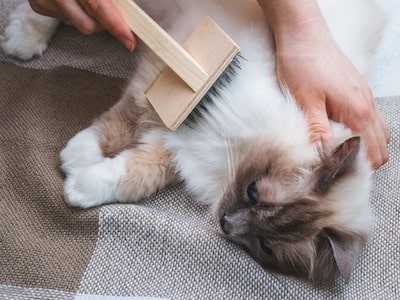
- Add omega–3 fatty acids to your cat’s diet.
- These are vital nutrients that promote the health of the skin and coat
- They can help lessen itchiness and irritation, which could make your cat lick or scratch themselves excessively.
- They can help lessen itchiness and irritation, which could make your cat lick or scratch themselves excessively.
- In liquid or pill form, omega–3 supplements are available at pet supply stores and online.
- As an alternative, you may give your cat some flaxseed or fish oil.
- These are vital nutrients that promote the health of the skin and coat

- the afflicted region with a topical cream or spray. Infection or inflammation can be avoided while also calming the skin.
- Aloe vera, chamomile, oats, lavender, or other natural substances can be found in products you can use.
- The skin may become dry or damaged by products that include alcohol, steroids, or artificial perfumes.
- Aloe vera, chamomile, oats, lavender, or other natural substances can be found in products you can use.
- Avoid exposing your cat to extreme temperatures or direct sunlight.
- This can damage the skin and hair and slow down the healing process. Keep your cat indoors or provide them with a shaded area if they go outside.
- You can also use a sunscreen specially formulated for cats if they have bald spots on their ears, nose, or other areas.
- This can damage the skin and hair and slow down the healing process. Keep your cat indoors or provide them with a shaded area if they go outside.
- Be patient and supportive of your cat. Hair growth takes time and varies from cat to cat.
- Do not compare your cat’s progress with others or expect them to look exactly like before.
- Your cat may feel insecure or uncomfortable with their appearance, so give them plenty of love and attention.
- Praise them for their beauty and personality, not just their fur.
- Do not compare your cat’s progress with others or expect them to look exactly like before.
FAQs
Can a cat’s hair grow back a different color or texture?
It’s unlikely that a cat’s hair will grow back with a different color or texture than their original coat. However, factors like age and health can influence hair quality, potentially leading to subtle changes in texture.
Are there specific factors that can delay hair regrowth in cats?
Yes, stress, poor nutrition, underlying health conditions, and certain medications can all contribute to delayed or abnormal hair regrowth in cats.
What should I do if my cat’s hair isn’t growing back as expected?
If you’re concerned about the pace or quality of your cat’s hair regrowth, it’s advisable to consult a veterinarian. They can assess your cat’s overall health, recommend any necessary dietary changes, and address any underlying issues that might be affecting regrowth.
Does a cat’s age affect the speed of hair regrowth?
Yes, kittens tend to have faster hair regrowth compared to adult cats. Kittens are in a phase of rapid development, which includes hair growth.
Can I do anything to speed up my cat’s hair regrowth?
While you can’t significantly accelerate the natural hair growth cycle, providing a nutritious diet, maintaining a stress-free environment, and practicing gentle grooming can promote optimal regrowth.
Conclusion
The process of cat hair development is intricate and influenced by several variables.
The time it takes for your cat’s fur to entirely regrow after being cut or shaved might range from a few weeks to a year.
To help your cat grow their hair back quicker and healthier, however, you can brush them frequently, add omega-3 fatty acids to their diet, apply a topical cream or spray to the affected area, stay out of direct sunlight and extreme temperatures, and be patient and kind to them.
Additionally, you may stop cats from losing their hair by feeding them a high-quality diet, keeping them hydrated, grooming them, shielding them from bugs and parasites, and lowering their stress and boredom.
Reference:
- Cat hair loss: causes and treatment | Best Friends Animal Society
- Cat allergies | WebMD
- Skin Infections in Cats | PetMD
- How to relieve cat stress? | CatLikesBest
- Mange in Cats: What You Need to Know | CatLikesBest

Dave is our best team member when it comes to taking care of pets on daily basis. This is because he used to be a full-time pet sitter before joining CatLikesBest. Besides contributing his precious knowledge on cat care tips and everyday-use pet products, he still does pet sitting as part of his hobby in his free time.

